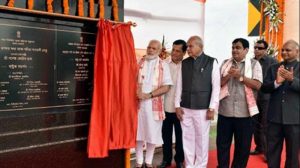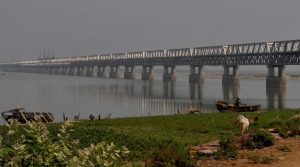India’s Longest Bridge and its strategic importance
The Dhola Sadiya Bridge gives the locals of Assam a new lifeline along with wider connectivity across the Northeast.

T he Dhola-Sadiya Bridge is India’s longest river bridge constructed over river Lohit, which is a tributary of Brahmaputra. It connects Dhola in Assam to Sadiya in Arunachal Pradesh. The bridge is named as the “Bhupen Hazarika Setu”, as a tribute to the legendary singer Dr. Bhupen Hazarika from Assam whose birth places was Sadiya.
The idea of the project had started taking shape in the year 2003 under Atal Bihari Vajpayee government but because he couldn’t win the next elections, the project came to a standstill. The construction started in November 2011 and took six years to complete. Later it was inaugurated by PM Narendra Modi on May 26, 2017.
“Dr Bhupen Hazarika was instrumental in introducing the Brahmaputra to the world through his songs. His lips often glorified the potential and grandeur of the mighty river. His name must be attached with the bridge,” said Modi in an interview with a daily newspaper in Assam.
The bridge holds strategic importance and is believed to boost the Indian economy. It promises to offer relief to the existing transport networks, inviting various developmental, health, educational and production activities and expediting industrial investments along with promoting the tourism sector of the state. The project is under a public-private partnership (PPP) between the Ministry of Road Transport and Highways and a private firm, Navayuga Engineering Company.
“The Northeast being a high seismic zone, the bridge was built using hydraulic rigs and seismic buffers in all its 182 piers to withstand earthquakes.”
 It has been reported in one of the local newspapers that the Assam Chief Minister Sarbananda Sonowal believes that this bridge will further help enhance connectivity in the Northeastern region as the bridge will serve the purpose of people of Assam and Arunachal Pradesh. Emphasising on the border aspect, he believes that Assam and Arunachal Pradesh have huge strategic value vis-à-vis the country. Since the bridge is constructed very close to India’s borders with China, it will help in quick movement of military troops and artillery in times of conflict. The bridge is seen as an attempt by India to fulfill its defense requirements along the borders and to make its connectivity stronger..
It has been reported in one of the local newspapers that the Assam Chief Minister Sarbananda Sonowal believes that this bridge will further help enhance connectivity in the Northeastern region as the bridge will serve the purpose of people of Assam and Arunachal Pradesh. Emphasising on the border aspect, he believes that Assam and Arunachal Pradesh have huge strategic value vis-à-vis the country. Since the bridge is constructed very close to India’s borders with China, it will help in quick movement of military troops and artillery in times of conflict. The bridge is seen as an attempt by India to fulfill its defense requirements along the borders and to make its connectivity stronger..
The bridge also helps strengthen the connectivity of Arunachal Pradesh and Assam as it reduces the travel time between Arunachal Pradesh and Assam by five hours. Also, the import of goods between these states will be much easier and cost effective through this bridge.
“It has been estimated that a total sum of Rs 2,056 crore has been spent on the construction of the bridge which can withstand about 60 tons of weight.”
Earlier the locals had to travel eight hours to reach across by ferry and during monsoons, there was no means to commute. A large number of people living in the remote border areas of Assam and Arunachal Pradesh are happy about it, owing to the difference it has made to their daily lives. The bridge not only helps the army access extremely remote parts of the Chinese border, along the Anjaw and Dibang valley of Arunachal, but also allows them to move tanks over that area. Earlier, they were solely dependent, even during medical and other emergencies, on a fleet of ferries.
“Besides improving the life of locals, this bridge will change the economy of many remote parts of Arunachal Pradesh.”
The bridge also has an important role to play in the border areas of Arunachal Pradesh, by facilitating hydro power projects coming up in the state. It will mainly help the Army to reach outposts near the China border. Hand in hand, it is believed to boost tourism as there isn’t any civilian airport in Arunachal Pradesh and this will make the road transport smoother and easier. Industrial investments with better border trade between the Northeast and South Asian countries will also increase.
